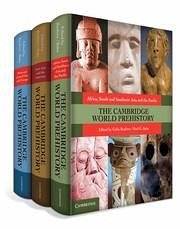The Cambridge World Prehistory 3 Volume Hb Set
Herausgeber: Renfrew, Colin; Bahn, Paul
The Cambridge World Prehistory 3 Volume Hb Set
Herausgeber: Renfrew, Colin; Bahn, Paul
- Broschiertes Buch
- Merkliste
- Auf die Merkliste
- Bewerten Bewerten
- Teilen
- Produkt teilen
- Produkterinnerung
- Produkterinnerung
The Cambridge World Prehistory provides a systematic and authoritative examination of the prehistory of every region around the world.
Andere Kunden interessierten sich auch für
![The Cambridge World History of Violence 4 Volume Hardback Set The Cambridge World History of Violence 4 Volume Hardback Set]() The Cambridge World History of Violence 4 Volume Hardback Set667,99 €
The Cambridge World History of Violence 4 Volume Hardback Set667,99 €![The Cambridge History of Nationhood and Nationalism 2 Volume Hardback Set The Cambridge History of Nationhood and Nationalism 2 Volume Hardback Set]() The Cambridge History of Nationhood and Nationalism 2 Volume Hardback Set299,99 €
The Cambridge History of Nationhood and Nationalism 2 Volume Hardback Set299,99 €![The Cambridge History of the Napoleonic Wars 3 Volume Hardback Set The Cambridge History of the Napoleonic Wars 3 Volume Hardback Set]() The Cambridge History of the Napoleonic Wars 3 Volume Hardback Set445,99 €
The Cambridge History of the Napoleonic Wars 3 Volume Hardback Set445,99 €![The Cambridge History of Medieval Music 2 Volume Hardback Set The Cambridge History of Medieval Music 2 Volume Hardback Set]() The Cambridge History of Medieval Music 2 Volume Hardback Set316,99 €
The Cambridge History of Medieval Music 2 Volume Hardback Set316,99 €![The Cambridge History of the European Union 2 Volume Hardback Set The Cambridge History of the European Union 2 Volume Hardback Set]() The Cambridge History of the European Union 2 Volume Hardback Set299,99 €
The Cambridge History of the European Union 2 Volume Hardback Set299,99 €![The Cambridge Global History of Fashion 2 Volume Hardback Set The Cambridge Global History of Fashion 2 Volume Hardback Set]() The Cambridge Global History of Fashion 2 Volume Hardback Set297,99 €
The Cambridge Global History of Fashion 2 Volume Hardback Set297,99 €![The Cambridge History of British Foreign Policy, 1783-1919 3 Volume Set The Cambridge History of British Foreign Policy, 1783-1919 3 Volume Set]() The Cambridge History of British Foreign Policy, 1783-1919 3 Volume Set250,99 €
The Cambridge History of British Foreign Policy, 1783-1919 3 Volume Set250,99 €-
-
-
The Cambridge World Prehistory provides a systematic and authoritative examination of the prehistory of every region around the world.
Hinweis: Dieser Artikel kann nur an eine deutsche Lieferadresse ausgeliefert werden.
Hinweis: Dieser Artikel kann nur an eine deutsche Lieferadresse ausgeliefert werden.
Produktdetails
- Produktdetails
- Verlag: Cambridge University Press
- Seitenzahl: 2049
- Erscheinungstermin: 9. Juni 2014
- Englisch
- Abmessung: 290mm x 226mm x 109mm
- Gewicht: 6645g
- ISBN-13: 9780521119931
- ISBN-10: 0521119936
- Artikelnr.: 35483698
- Herstellerkennzeichnung
- Libri GmbH
- Europaallee 1
- 36244 Bad Hersfeld
- gpsr@libri.de
- Verlag: Cambridge University Press
- Seitenzahl: 2049
- Erscheinungstermin: 9. Juni 2014
- Englisch
- Abmessung: 290mm x 226mm x 109mm
- Gewicht: 6645g
- ISBN-13: 9780521119931
- ISBN-10: 0521119936
- Artikelnr.: 35483698
- Herstellerkennzeichnung
- Libri GmbH
- Europaallee 1
- 36244 Bad Hersfeld
- gpsr@libri.de
Volume 1. Africa, South and Southeast Asia, and the Pacific: Part I. Introduction: 1. History of world prehistory
2. Chronology
3. Climatic change
4. Traditional themes
5. DNA
6. Language
Part II. Africa: 7. Early hominins
8. Earliest industries
9. The human revolution
10. Homo fossils
11. Middle Stone Age of Subsaharan Africa
12. Late Stone Age of Southern Africa
13. North Africa
14. West Africa
15. Central Africa
16. Southern Africa
17. East Africa and Madagascar and the Emergence of Northeast African states
18. Neolithic and Predynastic Egypt
19. Emergence of the Egyptian state
20. Summary of dynastic Egypt
21. Summary of Classical and post-Classical Africa
22. Languages
Part III. South and Southeast Asia: 23. Palaeolithic of South Asia
24. Pre-Upper Palaeolithic Southeast Asia, including Flores
25. DNA
26. Upper Palaeolithic of Southeast Asia
27. Food production in India and Sri Lanka
28. Harappan
29. Post-Harappan
30. Summary of historic India and Sri Lanka
31. Food production in Southeast Asia
32. Complex society of Southeast Asia
33. Summary of Khmer
34i. Indonesia
34ii. The Philippines
35. Languages
Part IV. The Pacific: 36. DNA
37. Palaeolithic of Australia, New Guinea, and Bismarcks
38. Later prehistory of New Guinea
39. Later prehistory of Australia
40i. Micronesia
40ii. Melanesia
41. Polynesia, including Hawaii and Easter Island
42. New Zealand
43. Languages. Volume 2. East Asia and the Americas: Part V. East Asia: 1. DNA
2. Pre-Upper Palaeolithic
3. Upper Palaeolithic
4. Early sedentism of the Pacific coast and early Jomon
5. Neolithic of Northern and Central China
6. Neolithic of Southern China, including Tibet
7. Early complex societies in the Yellow River and Northern China
8. Early complex societies in Southern China, including Tibet
9. Summary of ancient China
10. Complex society in Japan and Korea
11. Later prehistory of Eastern Siberia
12. Languages
Part VI. The Americas: 13. DNA
14. The first Americans
15. Paleoindian and Archaic of North America
16. Paleoindian and Archaic of Central and South America
17. Domestication and Formative of Mesoamerica
18. Domestication and Formative of South America
19. Valley of Mexico
20. Olmecs and Gulf Coast
21. Oaxaca
22. Maya
23. Early coastal South America
24. Early Horizon
25. Early Intermediate and Middle Horizon
26. Late Horizon
27. Colombia, Ecuador, and Venezuela
28. Amazonia
29. Paraguay, Uruguay, Argentina, Chile and Patagonia
30. Caribbean islands and neighbouring South American coast
31. The South-West
32. The North Pacific coast
33 Plains and Mississippian
34. The Atlantic coast from Florida to New England
35. Northern North America
36. Languages. Volume 3. Part VII. Western and Central Asia: 1. Pre-Upper Palaeolithic
2. DNA
3. Upper Palaeolithic
4. Origins of sedentism and agriculture
5. The Levant and Cyprus
6. Western Syria
7. Mesopotamia and Iran, the first cities
8. Summary of Akkad onwards
9. Anatolia up to 2000 BC
10. Anatolia after 2000 BC
11. The Caucasus, including Georgia and Armenia
12. Arabia
13. Central Asia before the Silk Road
14. Southern Siberia
15. Summary of the post-Classical and Islam
16 Languages
Part VIII. Europe and the Mediterranean: 17. The Pre-Upper Palaeolithic
18. DNA
19. Upper Palaeolithic
20. Upper Palaeolithic imagery
21i. Post-Pleistocene and early food production in Southern Europe
21ii. Post-Pleistocene and early food production in Southern Europe
22. Post-Pleistocene and early food production in Northern Europe
23. The Aegean
24. Post-Neolithic of Western Europe
25. Post-Neolithic of Central and Northern Europe, including the Scandinavian Bronze Age
26. Post-Neolithic of Eastern Europe
27. Summary of the Classical World
28. Languages.
2. Chronology
3. Climatic change
4. Traditional themes
5. DNA
6. Language
Part II. Africa: 7. Early hominins
8. Earliest industries
9. The human revolution
10. Homo fossils
11. Middle Stone Age of Subsaharan Africa
12. Late Stone Age of Southern Africa
13. North Africa
14. West Africa
15. Central Africa
16. Southern Africa
17. East Africa and Madagascar and the Emergence of Northeast African states
18. Neolithic and Predynastic Egypt
19. Emergence of the Egyptian state
20. Summary of dynastic Egypt
21. Summary of Classical and post-Classical Africa
22. Languages
Part III. South and Southeast Asia: 23. Palaeolithic of South Asia
24. Pre-Upper Palaeolithic Southeast Asia, including Flores
25. DNA
26. Upper Palaeolithic of Southeast Asia
27. Food production in India and Sri Lanka
28. Harappan
29. Post-Harappan
30. Summary of historic India and Sri Lanka
31. Food production in Southeast Asia
32. Complex society of Southeast Asia
33. Summary of Khmer
34i. Indonesia
34ii. The Philippines
35. Languages
Part IV. The Pacific: 36. DNA
37. Palaeolithic of Australia, New Guinea, and Bismarcks
38. Later prehistory of New Guinea
39. Later prehistory of Australia
40i. Micronesia
40ii. Melanesia
41. Polynesia, including Hawaii and Easter Island
42. New Zealand
43. Languages. Volume 2. East Asia and the Americas: Part V. East Asia: 1. DNA
2. Pre-Upper Palaeolithic
3. Upper Palaeolithic
4. Early sedentism of the Pacific coast and early Jomon
5. Neolithic of Northern and Central China
6. Neolithic of Southern China, including Tibet
7. Early complex societies in the Yellow River and Northern China
8. Early complex societies in Southern China, including Tibet
9. Summary of ancient China
10. Complex society in Japan and Korea
11. Later prehistory of Eastern Siberia
12. Languages
Part VI. The Americas: 13. DNA
14. The first Americans
15. Paleoindian and Archaic of North America
16. Paleoindian and Archaic of Central and South America
17. Domestication and Formative of Mesoamerica
18. Domestication and Formative of South America
19. Valley of Mexico
20. Olmecs and Gulf Coast
21. Oaxaca
22. Maya
23. Early coastal South America
24. Early Horizon
25. Early Intermediate and Middle Horizon
26. Late Horizon
27. Colombia, Ecuador, and Venezuela
28. Amazonia
29. Paraguay, Uruguay, Argentina, Chile and Patagonia
30. Caribbean islands and neighbouring South American coast
31. The South-West
32. The North Pacific coast
33 Plains and Mississippian
34. The Atlantic coast from Florida to New England
35. Northern North America
36. Languages. Volume 3. Part VII. Western and Central Asia: 1. Pre-Upper Palaeolithic
2. DNA
3. Upper Palaeolithic
4. Origins of sedentism and agriculture
5. The Levant and Cyprus
6. Western Syria
7. Mesopotamia and Iran, the first cities
8. Summary of Akkad onwards
9. Anatolia up to 2000 BC
10. Anatolia after 2000 BC
11. The Caucasus, including Georgia and Armenia
12. Arabia
13. Central Asia before the Silk Road
14. Southern Siberia
15. Summary of the post-Classical and Islam
16 Languages
Part VIII. Europe and the Mediterranean: 17. The Pre-Upper Palaeolithic
18. DNA
19. Upper Palaeolithic
20. Upper Palaeolithic imagery
21i. Post-Pleistocene and early food production in Southern Europe
21ii. Post-Pleistocene and early food production in Southern Europe
22. Post-Pleistocene and early food production in Northern Europe
23. The Aegean
24. Post-Neolithic of Western Europe
25. Post-Neolithic of Central and Northern Europe, including the Scandinavian Bronze Age
26. Post-Neolithic of Eastern Europe
27. Summary of the Classical World
28. Languages.
Volume 1. Africa, South and Southeast Asia, and the Pacific: Part I. Introduction: 1. History of world prehistory
2. Chronology
3. Climatic change
4. Traditional themes
5. DNA
6. Language
Part II. Africa: 7. Early hominins
8. Earliest industries
9. The human revolution
10. Homo fossils
11. Middle Stone Age of Subsaharan Africa
12. Late Stone Age of Southern Africa
13. North Africa
14. West Africa
15. Central Africa
16. Southern Africa
17. East Africa and Madagascar and the Emergence of Northeast African states
18. Neolithic and Predynastic Egypt
19. Emergence of the Egyptian state
20. Summary of dynastic Egypt
21. Summary of Classical and post-Classical Africa
22. Languages
Part III. South and Southeast Asia: 23. Palaeolithic of South Asia
24. Pre-Upper Palaeolithic Southeast Asia, including Flores
25. DNA
26. Upper Palaeolithic of Southeast Asia
27. Food production in India and Sri Lanka
28. Harappan
29. Post-Harappan
30. Summary of historic India and Sri Lanka
31. Food production in Southeast Asia
32. Complex society of Southeast Asia
33. Summary of Khmer
34i. Indonesia
34ii. The Philippines
35. Languages
Part IV. The Pacific: 36. DNA
37. Palaeolithic of Australia, New Guinea, and Bismarcks
38. Later prehistory of New Guinea
39. Later prehistory of Australia
40i. Micronesia
40ii. Melanesia
41. Polynesia, including Hawaii and Easter Island
42. New Zealand
43. Languages. Volume 2. East Asia and the Americas: Part V. East Asia: 1. DNA
2. Pre-Upper Palaeolithic
3. Upper Palaeolithic
4. Early sedentism of the Pacific coast and early Jomon
5. Neolithic of Northern and Central China
6. Neolithic of Southern China, including Tibet
7. Early complex societies in the Yellow River and Northern China
8. Early complex societies in Southern China, including Tibet
9. Summary of ancient China
10. Complex society in Japan and Korea
11. Later prehistory of Eastern Siberia
12. Languages
Part VI. The Americas: 13. DNA
14. The first Americans
15. Paleoindian and Archaic of North America
16. Paleoindian and Archaic of Central and South America
17. Domestication and Formative of Mesoamerica
18. Domestication and Formative of South America
19. Valley of Mexico
20. Olmecs and Gulf Coast
21. Oaxaca
22. Maya
23. Early coastal South America
24. Early Horizon
25. Early Intermediate and Middle Horizon
26. Late Horizon
27. Colombia, Ecuador, and Venezuela
28. Amazonia
29. Paraguay, Uruguay, Argentina, Chile and Patagonia
30. Caribbean islands and neighbouring South American coast
31. The South-West
32. The North Pacific coast
33 Plains and Mississippian
34. The Atlantic coast from Florida to New England
35. Northern North America
36. Languages. Volume 3. Part VII. Western and Central Asia: 1. Pre-Upper Palaeolithic
2. DNA
3. Upper Palaeolithic
4. Origins of sedentism and agriculture
5. The Levant and Cyprus
6. Western Syria
7. Mesopotamia and Iran, the first cities
8. Summary of Akkad onwards
9. Anatolia up to 2000 BC
10. Anatolia after 2000 BC
11. The Caucasus, including Georgia and Armenia
12. Arabia
13. Central Asia before the Silk Road
14. Southern Siberia
15. Summary of the post-Classical and Islam
16 Languages
Part VIII. Europe and the Mediterranean: 17. The Pre-Upper Palaeolithic
18. DNA
19. Upper Palaeolithic
20. Upper Palaeolithic imagery
21i. Post-Pleistocene and early food production in Southern Europe
21ii. Post-Pleistocene and early food production in Southern Europe
22. Post-Pleistocene and early food production in Northern Europe
23. The Aegean
24. Post-Neolithic of Western Europe
25. Post-Neolithic of Central and Northern Europe, including the Scandinavian Bronze Age
26. Post-Neolithic of Eastern Europe
27. Summary of the Classical World
28. Languages.
2. Chronology
3. Climatic change
4. Traditional themes
5. DNA
6. Language
Part II. Africa: 7. Early hominins
8. Earliest industries
9. The human revolution
10. Homo fossils
11. Middle Stone Age of Subsaharan Africa
12. Late Stone Age of Southern Africa
13. North Africa
14. West Africa
15. Central Africa
16. Southern Africa
17. East Africa and Madagascar and the Emergence of Northeast African states
18. Neolithic and Predynastic Egypt
19. Emergence of the Egyptian state
20. Summary of dynastic Egypt
21. Summary of Classical and post-Classical Africa
22. Languages
Part III. South and Southeast Asia: 23. Palaeolithic of South Asia
24. Pre-Upper Palaeolithic Southeast Asia, including Flores
25. DNA
26. Upper Palaeolithic of Southeast Asia
27. Food production in India and Sri Lanka
28. Harappan
29. Post-Harappan
30. Summary of historic India and Sri Lanka
31. Food production in Southeast Asia
32. Complex society of Southeast Asia
33. Summary of Khmer
34i. Indonesia
34ii. The Philippines
35. Languages
Part IV. The Pacific: 36. DNA
37. Palaeolithic of Australia, New Guinea, and Bismarcks
38. Later prehistory of New Guinea
39. Later prehistory of Australia
40i. Micronesia
40ii. Melanesia
41. Polynesia, including Hawaii and Easter Island
42. New Zealand
43. Languages. Volume 2. East Asia and the Americas: Part V. East Asia: 1. DNA
2. Pre-Upper Palaeolithic
3. Upper Palaeolithic
4. Early sedentism of the Pacific coast and early Jomon
5. Neolithic of Northern and Central China
6. Neolithic of Southern China, including Tibet
7. Early complex societies in the Yellow River and Northern China
8. Early complex societies in Southern China, including Tibet
9. Summary of ancient China
10. Complex society in Japan and Korea
11. Later prehistory of Eastern Siberia
12. Languages
Part VI. The Americas: 13. DNA
14. The first Americans
15. Paleoindian and Archaic of North America
16. Paleoindian and Archaic of Central and South America
17. Domestication and Formative of Mesoamerica
18. Domestication and Formative of South America
19. Valley of Mexico
20. Olmecs and Gulf Coast
21. Oaxaca
22. Maya
23. Early coastal South America
24. Early Horizon
25. Early Intermediate and Middle Horizon
26. Late Horizon
27. Colombia, Ecuador, and Venezuela
28. Amazonia
29. Paraguay, Uruguay, Argentina, Chile and Patagonia
30. Caribbean islands and neighbouring South American coast
31. The South-West
32. The North Pacific coast
33 Plains and Mississippian
34. The Atlantic coast from Florida to New England
35. Northern North America
36. Languages. Volume 3. Part VII. Western and Central Asia: 1. Pre-Upper Palaeolithic
2. DNA
3. Upper Palaeolithic
4. Origins of sedentism and agriculture
5. The Levant and Cyprus
6. Western Syria
7. Mesopotamia and Iran, the first cities
8. Summary of Akkad onwards
9. Anatolia up to 2000 BC
10. Anatolia after 2000 BC
11. The Caucasus, including Georgia and Armenia
12. Arabia
13. Central Asia before the Silk Road
14. Southern Siberia
15. Summary of the post-Classical and Islam
16 Languages
Part VIII. Europe and the Mediterranean: 17. The Pre-Upper Palaeolithic
18. DNA
19. Upper Palaeolithic
20. Upper Palaeolithic imagery
21i. Post-Pleistocene and early food production in Southern Europe
21ii. Post-Pleistocene and early food production in Southern Europe
22. Post-Pleistocene and early food production in Northern Europe
23. The Aegean
24. Post-Neolithic of Western Europe
25. Post-Neolithic of Central and Northern Europe, including the Scandinavian Bronze Age
26. Post-Neolithic of Eastern Europe
27. Summary of the Classical World
28. Languages.








